Lea Wait's Blog, page 9
July 28, 2025
Late Blooming
It’s probably not an exaggeration to call myself a late bloomer.  My late August birthday barely got me into first grade at the right time. My social skills didn’t start to expand until I got to college. It took five or six years after college to find some work I could tolerate and I didn’t even commit myself to a relationship until my thirties. I enrolled as the oldest living graduate student at forty-something.
My late August birthday barely got me into first grade at the right time. My social skills didn’t start to expand until I got to college. It took five or six years after college to find some work I could tolerate and I didn’t even commit myself to a relationship until my thirties. I enrolled as the oldest living graduate student at forty-something.
My so-called career as a writer has followed that arc. Because I started out writing poetry, I had no delusions about making a living as a writer. I was deliberate about the fact that I wasn’t going to be the 1970s equivalent of a starving artist in a garret in Paris, so I knew I would have to find work. And publication, so random-seeming in the poetry world—didn’t concern me that much.
Same story, really, when I skipped over to writing prose—short stories at the start. The short fiction markets were well past the point of supporting a writer. One of my well-published mentors at UNH was fond of pointing out that in 1950, a short story in Esquire paid the writer $1000. That number hadn’t changed by 1990 (and probably still hasn’t) but in 1950, a writer could live on three or four thousand dollars a year. Try that now.
By the time I was serious about book length fiction, I was lucky that I didn’t need it to support me financially, which was both an engine and an anchor. It meant I didn’t have to write anything I didn’t want to, in whatever form or language I wanted to use. The anchor, of course, was that because I wasn’t pushing to publish, I didn’t develop a readership. With my non-writing work, I had time to write or market. I chose to write.
Which explains why my first book was published in 2016, the January after I reached the federal statutory retirement age. Making me a late bloomer indeed.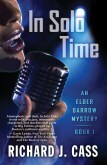
Paradoxically, my crime writer models were people like Elmore Leonard and John D. MacDonald, who published scores of books each in long careers, a book or two a year. Being a late bloomer makes that less likely. What I’ve gained, I think, through waiting this long to publish, is the sense that my work is as much my own as it can be. This is freedom, yes, and maybe an anchor, but it’s where I’ve come to.
Why belabor you with the story of my late bloomer life? Only because when I teach, and when I talk to writers starting out, I’m often struck by their impatience, the feeling that if they don’t succeed right away, right now, they are failures for life. Those of us who’ve been doing this for a while understand that writing is a long game, as is publication. (And they are two separate things.) Some of us may take longer to bloom than others, but it’s the work that matters, not how long it takes.
Sagging Middles
 Talk about life imitating art! Sagging middles describes it all. Some of you, of a certain age, are nodding in agreement. Others are scratching their heads. Stick with me here.
Talk about life imitating art! Sagging middles describes it all. Some of you, of a certain age, are nodding in agreement. Others are scratching their heads. Stick with me here.
I’m a runner. Not a competitive one, but one who ties on running shoes when the muse desserts.
This morning, at 8 AM, trying to think up a topic for this blog, I laced up my running shoes. Despite living in far northern Maine, the temps were in the high 70s. It was sticky humid, and the black flies and deer flies were lying in ambush. To compensate for the increased heat and bug induced blood loss, I’d cut my runs from five miles to three. By the time I ran the first mile and started the second, temps were topping the 80-degree mark. You see where I’m headed? Mile two, the middle mile. There I was, forcing one foot in front of the other thinking, I’ll never make it. My hamstring hurts. Is that a pain in my knee? I should stop. That’s when my watch chimed that I’d finished the second mile and was on the home stretch. The last mile. Energy flowed again. Heck, anyone can run a mile! And I had my topic.
Those dreaded middles. Of runs, of age, of stories. Middles are where all the action really happens. The first part of life, runs, and stories is the set up. The inciting incidents. The plans for attack. We don’t yet know exactly what’s going to happen, but the conflict is perking, most of the players have appeared on stage, and the basic story is taking shape. Now we are in for the longer jog. It’s the middle of the tale. The writer’s job is to move it along. Make it a page turner. Keep the reader caring while we bury the protagonist in crises and drop breadcrumbs for the ultimate resolution.

My Running Track
Kind of like life, or a run, there’s a lot of ground to cover in the middle. The middle of a book takes up danged near three quarters of the word real estate and it’s important it narrows to a satisfying ending. The middle is the terrible twos of writing. Everyone clamors for attention. The clues switch partners and dance. The villain laughs and calls the shots. Misdirection is rampant. The protagonist plays out every possible scenario in search of the golden key. Some bring her closer, others, not so much. It’s a balancing act for the writer. Make it interesting. Impart important information, keep the action and the timeline solid. Write, edit, cut, write, edit, cut, polish. In the middle every word has to count, and none of them can be flabby, or indulgent of sore knees,
The payoff? Emerging from the middle with a story that shines. Some writers and readers find the middle the most enticing part of a story. Others are eager for finish line. The end is a sprint. The last eighth or so of the story wraps all that went before into a satisfying finale yet leaves the reader eager for more and the writer bristling with ideas for the next one. Kind of like a runner’s high.
What kind of a reader/writer are you? Do you crave the building conflict of the middle or do you long for the final scene?
July 25, 2025
Weekend Update: July 26-27, 2025
 Next week at Maine Crime Writers there will be posts by Kait Carson (Monday), Dick Cass (Tuesday), and Kaitlyn Dunnett/Kathy Lynn Emerson (Friday).
Next week at Maine Crime Writers there will be posts by Kait Carson (Monday), Dick Cass (Tuesday), and Kaitlyn Dunnett/Kathy Lynn Emerson (Friday).
In the news department, here’s what’s happening with some of us who blog regularly at Maine Crime Writers:
 Join Maine Crime Writers Maureen Milliken, Matt Cost, Dick Cass and 18 other authors from all sorts of genres for both adults and kids, at the Belgrade Book Bash, 10 a.m.-2 p.m. Sunday, July 27, at The Barn at Seven Lakes Inn, 168 Main St., Belgrade. There will be a free raffle (no purchase required), a food truck, and all in a beautiful setting! Come on by and say hi!
Join Maine Crime Writers Maureen Milliken, Matt Cost, Dick Cass and 18 other authors from all sorts of genres for both adults and kids, at the Belgrade Book Bash, 10 a.m.-2 p.m. Sunday, July 27, at The Barn at Seven Lakes Inn, 168 Main St., Belgrade. There will be a free raffle (no purchase required), a food truck, and all in a beautiful setting! Come on by and say hi!
MATT COST will be at the Grand Opening of Books-A-Million in Auburn, Maine, today (Saturday) from 1-2:30 PM signing copies of THE NOT SO MERRY ADVENTURES OF MAX CREED. Stop by and say hi.
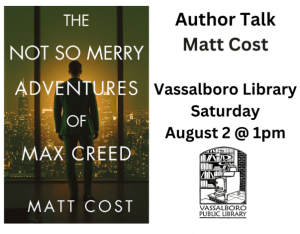
On Saturday, August 2nd, there will be COST TALK at the Vassalboro Library at 1 PM.
An invitation to readers of this blog: Do you have news relating to Maine, Crime, or Writing? We’d love to hear from you. Just comment below to share.
And a reminder: If your library, school, or organization is looking for a speaker, we are often available to talk about the writing process, research, where we get our ideas, and other mysteries of the business, along with the very popular “Making a Mystery” with audience participation, and “Casting Call: How We Staff Our Mysteries.” We also do programs on Zoom. Contact Kate Flora
Forty-Year-Old Clues to the Muse
Sandra Neily here:
Recently, I unearthed a journal I kept long ago when I traveled alone with my dog Harry, across the country and into western states I wanted to explore. Today I think I was looking for clues to my author and my nature-writing self.
I’ve selected just a few bits here
********
Sept 12, 1977
I should have taken off in the early seventies after college. After those four years (1967-1971) of prime Paul Harvey material: drugs, co-ed living, demonstrations against the war, student rights marches, the women’s movement.
I’m fairly sure that little can be said of those years. At least not precisely as I feel language did not function well during those years. It’s the revenge of that inarticulate and thrashing space. No one can adequately explain the first time you rolled on the grass in a wind of Mescaline energy, or the night of snow and wind when your roommate was gone and you finally got to wake up shyly with your first lover, or the rage of that one picture of a girl kneeling over a dead boy, her mouth stretched in a Kent State silent scream. 
Right after college I wouldn’t have paid my car insurance ahead in one lump sum, alert my bank and credit cards about a new address, and check my files for legal papers that should go with me. Seven years ago, I might not have vaccinated by dog and seen the dentist before I “split.” Although I will travel light, I do have a very used Volvo wagon that holds my black lab (about 74 lbs. of Harry), 25 lbs. of dog food, skis and other light jock equipment, back pack, sleeping bag, tent purchased with books of Green Stamps, cooler, and a roof rack with duffels of winter clothes and suitable work clothes. (I will run out of money soon.)
And books. An entire compartment of them wedged around my spare tire.
…
Tomorrow, I drop off the edge of all that I have known for most of my life and head west. Now I know there will be nights alone in campgrounds and parks. Nights when I curse the wind that makes lighting my stove a trial and nights when Cup-A-Soup is a poor substitute for a simmering beef stew. Yet I hope there will be days and nights when the exhilaration of being alone and choosing my route or trail of even the flavor of soup will reward me for my courage.
is a poor substitute for a simmering beef stew. Yet I hope there will be days and nights when the exhilaration of being alone and choosing my route or trail of even the flavor of soup will reward me for my courage.
…
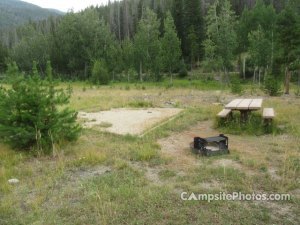
Timber Creek tent site. (There are over 200 RV sites just over my shoulder….)
(Note: Some journal entries are just quick notes, but they call up details that I remember so clearly.) Timber Creek, CO campground. Harry lands on flock of ducks in front of a ranger. Elk whistles and antler crashing wake us. Jerry and the motorcycle boys from Indianapolis invite us for steak dinner. Hiking into Arapahoe National Forest, Harry dismantles a beaver dam while I sleep.
…
Up through the last arid valleys of Idaho, the Tetons parked themselves just beyond the wheat. Ringed in clouds like frosty breath, they are cold and dark as I near Teton pass.
…

the Grand Teton
I sit, shirt open, boots off, bandaids on toes, butterflies on knees, before the most beautiful mountains yet, the Tetons. Perhaps they’re so impressive because you can almost drive to the base and the Grand scowls at you from 13,770 feet. Yesterday I hiked around Jenny Lake which mirrors the peaks and up into Cascade Canyon. Passing moose, deer, rabbits on route, I left the trail when it began to descend into the river. I climbed straight up over small cliffs and elk droppings until I could face the Grand and hear the snow rustling off its ice walls.
The altitude and sun have attacked all my bodily functions and all I can do is pant and reach back into my sea-level lungs for energy. (My car is having the same trouble; must get my carburetor adjusted!)
…
Last night the air was filled with delicate bugs who fell as couples onto the map I opened. They never fell as singles but always locked together. Thousands, all coupling frantically before they die or freeze or fall to earth on someone’s map to lie helpless over the topographical green of the Teton Mountains.
…

Jenny Lake and the Tetons
I haven’t commented much on the people. I have met so many everywhere and have usually never lacked for company if I want it. Here follows a brief catalogue of those I met while camped at Jenny Lake. I usually approach people to ask about hikes and bears and local info. I met Mark and Grey from Oklahoma this way. In long luscious southern vowels, they traded stories about Alabama and Mardi Gras and traveling. We took a short hike together, but the freezing wind sent us back to collect firewood. They bought me batteries on a trip to town and later I joined them for hotdogs at their fire.
Chris was waiting at my campsite when I returned from getting water. He hung around through my dinner, got out my Volvo manual, and gave me instructions about batteries, water, brake fluid, and carburetors. He was quick to admit he’d lost his job as a meat cutter, and later, after I walked Harry, I heard his soft drawl in the dark beyond his coals tell me he could show me Ohio if I wanted a passenger. He wasn’t offering a relationship, but he did say I was a “fox.”
Note: (I sometimes slept in the car with Harry if I felt a safety issue developing whether it might be a Chris or bear country.)
There were two young women from Augusta, Maine who showed me pictures of their yurt, stable, outhouse, and pasture fence they had built by themselves. They assured me they knew nothing beforehand and encouraged me to keep going … no matter what. They were inspirational.
…
I’ve discovered (while reading “Lolita”) I’ve been sitting on a pile of elk droppings. The muse works in mysterious ways. Perhaps the Greeks had it all wrong. The muse does not arrive on celestial wings but ferments under your rear as you write; the manure is transmogrified into your system and works like compost on your pen.
********

Mirror Lake unfrozen (Pacific Crest Trail)
I eventually made it to the Pacific Crest trail with the help of gentle and patient, and amazing Steve, who was on leave from being a government inspector on a tuna boat. We camped up through dripping rain forest to Mirror Lake, which was totally frozen by the time we got there. A few weeks later, I turned around after a November visit to the San Juan Islands (Washington) where I stayed with a classmate running a salmon farm. Fabulous dinners and a ferry boat rescue after our sailboat’s mast snapped in half. (Not all bad. While we waited for rescue, sea otters pressed around us, lying on their backs and cracking open seafood with rocks they held in their paws. Ya just never know.)
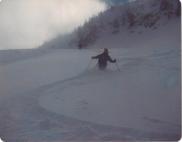 Later on, as I wintered and worked in Salt Lake (where the skis got used), gentle Steve and his buddies would come get Harry and carry him off to a camp in McCall, Idaho. For a vacation. Harry sent me postcards from a McCall bar.
Later on, as I wintered and worked in Salt Lake (where the skis got used), gentle Steve and his buddies would come get Harry and carry him off to a camp in McCall, Idaho. For a vacation. Harry sent me postcards from a McCall bar.
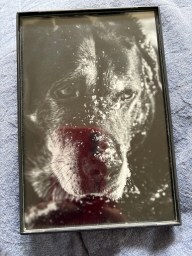 The entire journey would not have possible without my loved-so-much Harry, wh
o composed a book while we hiked, “Places I Have Pissed and Swum in the Great Northwest.” My job was to chant and sing the short chapters as we marched along.
The entire journey would not have possible without my loved-so-much Harry, wh
o composed a book while we hiked, “Places I Have Pissed and Swum in the Great Northwest.” My job was to chant and sing the short chapters as we marched along.
*************
Sandy’s debut novel, “Deadly Trespass, A Mystery in Maine” won a national Mystery Writers of America award, was a finalist in the Women’s Fiction Writers Association “Rising Star” contest, and was a finalist for a Maine Literary Award. The second Mystery in Maine, “Deadly Turn,” was published in 2021. Her third “Deadly” is due out in 2025. Find her novels at all Shermans Books (Maine) and on Amazon. Find more info on Sandy’s website.
won a national Mystery Writers of America award, was a finalist in the Women’s Fiction Writers Association “Rising Star” contest, and was a finalist for a Maine Literary Award. The second Mystery in Maine, “Deadly Turn,” was published in 2021. Her third “Deadly” is due out in 2025. Find her novels at all Shermans Books (Maine) and on Amazon. Find more info on Sandy’s website.
July 23, 2025
Mystery-writing lessons from ‘Jaws’
I saw the movie “Jaws” the summer it came out. Over and over and over and over again. There wasn’t a lot to do in Augusta, Maine, in the summer in the 1970s. But I also just couldn’t get enough of that movie. At 14, I couldn’t have told you why. It thrilled me way beyond the scary parts.
I don’t believe I’ve seen it at all in the years since it came out in 1975. If I did, it was decades ago. It’s now on streaming, in celebration of its 50th anniversary (Peacock+ and Netflix). I’ve watched it three times in the past two weeks and now, with 50 years of reading and writing behind me, I can tell you exactly why it was great then and it’s great now.
I know you’re likely poo-pooing that. It’s just another summer disaster movie, right? That’s what I would’ve said in the years since I’d seen it. I would’ve been wrong.
“Jaws” is to good story structure and writing what a Great White shark is to the ocean — “a perfect engine,” as the shark was described in the movie. The movie itself is, too. It’s a a lean, efficient machine. And it does it well enough that it tells a perfect story. [This is the movie, I’m talking about, not the Peter Benchley novel the movie is based on. Benchley wrote the screenplay with Carl Gottlieb, but it’s a much more perfect engine than the book.]
Watch it as a writer, and you’ll see. I’ll sum up its biggest lessons for writers here. I’ll try not to give too many spoilers, but come on, folks, it’s been 50 years. The spoiler statute of limitations must be expired by now.
Don’t show the shark too soon. The movie is masterful at building suspense. In two hours we don’t see the shark until the exact middle — the one-hour mark. It’s another 30 minutes before we see it again.
That doesn’t mean there’s no scary suspense. What do we see? A young woman getting repeatedly jerked under the water by an unseen attacker. You see little Alex Kintner’s rubber raft upend, and then a plume of blood. You see a dock getting pulled in half and going out to sea, then as the hapless guy on the dock frantically swims to shore, the dock slowly turns around and follows him. The head of Ben Gardner, the town’s best fisherman, popping out from the destroyed hull of his boat.
Even after we finally see the shark, the movie doesn’t overdo it. One of the most chilling moments in the movie is when the police chief, shark hunter and shark expert guy are in the boat, kind of drunk and singing. The view switches from inside the boat to outside. It’s dark, the boat is in the distance lit up, their singing faintly ringing across the water. Then, in the foreground, the plastic barrel they’d earlier attached to the shark pops up out of the water. There’s a pause, then it starts moving toward the boat.
Lesson for writers? Don’t pile it all on at once. Build the suspense, piece by piece, making it more powerful each time. And then, once you’ve done the big reveal, don’t overdo it. What’s not seen is scarier than what’s seen.
More dialogue, less exposition. The script of “Jaws” is just about perfect. We learn an incredible amount from conversations, many of them brief. This includes the police chief’s background, why he came form New York City to work on Amity Island, why some townspeople would rather roll the dice on a possible killer shark than close the beaches, and a ton of stuff about sharks — all through dialogue. The little bit of exposition in the movie feels natural and organic.
Lesson for writers? Tell the story through the characters, what they say and how they reaction. And they don’t need to say a lot, just enough, and the right way.
Natural dialogue. I’ve really tired over the last two or three decades of wise-guy movie (and book) dialogue. I call it Lethal Weapon/Die Hard syndrome. The guy holding the gun? The guy at the other end of the gun? All the people in between? Everyone’s an over-confident tough guy with wise-guy patter and catchphrases. I even saw Superman doing it in a trailer for his later movie. It’s like the script writers (or book writers) are just looking to create the latest catchphrase, rather than tell the story. It’s tiresome, trite, lazy, bad writing. When every reaction is LWDH syndrome, it flattens the story and characters.
Dialogue should be the utility player of a book, serving a lot of purposes. Not only to get in information and background, as noted above, but to develop character, convey mood, slow or speed up pace, and much more.
“Jaws” does that. Sure there are jokes and sarcastic asides and a wisecrack or two, but they’re a natural part of the dialogue and true to the characters. Some of them have become catchphrases, but “Jaws” was made long before the catchphrase era, and they weren’t intended to be.
People may remember one of the movie’s most famous lines, “You’re going to need a bigger boat,” as just the kind of wisecrack BS I’m talking about. The ultimate catchphrase. It’s definitely used that way today. But it wasn’t in the movie. It comes after the second appearance of the shark, a full-face leap at the police chief, at a point when everyone’s guard is down. When Roy Scheider, as the chief, says it, it’s not a wisecrack. He’s in shock, terrified, and he really, really thinks they need a bigger boat. In fact, he asks Quint, the shark catcher, two more times during the rest of the movie if they’re going to get a bigger boat. It’s so much better than a throwaway wisecrack.
When there isn’t a wisecrack or joke punctuating every tense situation, characters can develop more fully. They can be vulnerable or smart or insightful in a way that the buddy-movie approach doesn’t allow. It makes for a much better story.
Lesson for writers? Don’t base your dialogue on superhero and buddy movies. Instead, consider how your characters think and see the world, and what their purpose is in the book, and allow them to fully express themselves.
Character development. The main characters are the same archetypes you see in many movies and crime novels — the reluctant hero, the concerned wife, the guy who knows things are really bad but no one will listen to him, the rogue that you have to depend on to save the village. That said, in “Jaws” they are not caricatures. The script and good acting combine to give them nuance and story arcs that work. The fact that the dialogue is not just a string of exposition, wisecracks and catch phrases helps. Even the mayor, the typical guy who does not want to close the beaches and lose the tourist trade, has some depth. When he says to the police chief, “My kids were on that beach, too,” you believe his distress.
Lesson to writers? Sure, you may have some of the standard-issue characters. But that doesn’t mean they have to be cartoons.
Less is more. There are so many scenes in the movie that easily could’ve been overblown and melodramatic, a lot of the cliche stuff you expect to see or read these days. The movie in its lean and efficient way, avoids those overblown scenes we’re conditioned to see.
A great example is when the chief tells his wife to take their youngest home. They’re at the hospital after a harrowing event, and she’s obviously had enough. She says, “Home? To New York?” He says, quietly, “Home. Here.” They look at each other for a beat, she gives a very small resigned nod, and leaves with the kid. A lot was said in those few words. It was so much better than some big screaming argument about the island, the shark, the kids, blah blah blah. Masterful. There are many moments like that in the movie.
And at the end, when the police chief does what he does to solve the shark problem [I won’t spoil it!], it’s not some overdone wisecracking extravaganza. He’s terrified, a little panicked, but knows what he has to do and with some skill and luck, manages it. And as a bonus, it’s not punctuated with wisecracks or catchphrases. He does say, “Smile you son of a bitch,” but it’s out of desperation, not to be s smart aleck.
Lesson for writers? If you do it right, the scene or situation will carry itself without a lot of bells and whistles.
It’s not about the shark. Even though I binge-watched “Jaws” 50 years ago and have again the last week or so, I have no interest in sharks. None. Zero. Zilch. Nada. Shark Week comes and goes without me giving one thought to sharks.
“Jaws,” though, isn’t about the shark. It’s a horror movie in the best sense of the word. There’s a mostly unseen terrifying thing that is killing people, and they are slow on the uptake, then have no control over it. It’s about fear, obsession, vulnerability, human weakness and strength, and human interaction.
Lesson for writers? The crime or murder in a mystery novel is the vehicle for the real story. What’s your real story about?
July 22, 2025
Libraries Make the Reading World Go Round
Libraries are the Center of their Towns and Hub of their Communities
One of the great things about being an author is the opportunity to visit libraries as a speaker. I do a variety of COST TALKs around New England, mostly in Maine, and am always blown away by the libraries I visit. They are usually the center of town, the hub of the community, and the place where ideas and creativity are born and fostered.
If you are a librarian or belong to a book group that meets at a library, I’d love to come speak, interact, or whatever. Libraries makes the reading world go round.
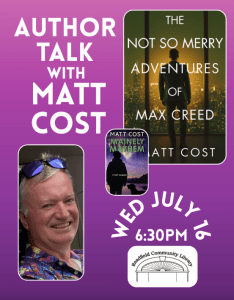
Wednesday night I was at the fabulous Readfield Community Library for the sixth time in five years, making it my most visited venue over that period, which is how long I have been a published author. In the center of town, in a flower garden, on the shores of Maranacook Lake, I got the opportunity to spout about books.
This made me want to reflect upon my journey along the library path this year. So far, there have been seventeen of these book repositories visited with many more to come. For me, this is one of the highlights of being a writer—getting out to appreciate the buildings, meet the librarians, and interact with the patrons of said establishments.
My first sojourn of the year was to the Windham Public Library in February where Dick Cass set up a Mystery Making event. Unfortunately, he had to bow out, but I had a wonderful time with Jule Selbo, Maureen Milliken, and Allison Keeton. If you haven’t gotten a chance to attend one of these panels where the authors, along with audience participation, create a crime story in an hour, you have been missing out.
March contained a visit to the Charlotte Hobbs Memorial Library in Lovell and a trip to Massachusetts for the Merrimac Public Library. At the Charlotte Hobbs, I did my COST TALK with a focus on my recently published book, Mainely Mayhem. Then, in Merrimac, I had the pleasure of moderating a discussion with wonderful authors BJ Magnani and Edie Maxwell.
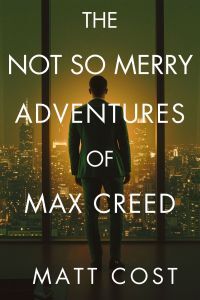
My first visit to the Brown Memorial Library in Clinton was a fantastic experience and my COST TALK focused on my latest offspring, The Not So Merry Adventures of Max Creed. This was followed by being the featured guest of the Sounding Board writing group at the Skidompha Library in Damariscotta.
Brown and Skidompha kicked off a busy month of May in which I did COST TALKS on the latest book at the Hartland Public Library where I heard a great story about my books being enjoyed by patrons more than a certain best-selling Maine author. Then the Bigelow Library in Clinton, but this was Massachusetts, not Maine, giving me two Clintons under my belt in a matter of weeks. I had a repeat visit to the fabulous Baxter Memorial Library, and then another Brown, but this time The Albert Church Brown Library in China Village for my second year in a row. The month finished off with a great conversation at the Richmond Library.
June began with a visit to my old stomping grounds at the Skowhegan Free Library, followed by the Canaan Public Library, the Dr. Shaw Memorial Library in the beautiful town of Mt. Vernon, over to the Norway Memorial Library, and then up into the heart of Maine at the Farmington Public Library. We concluded the month with a wonderful conversation over on the edge of New Hampshire at the Fryeburg Public Library.
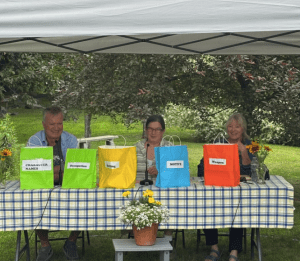
July has seen back-to-back visits to the Readfield Public Library. Upcoming, I have COST TALKs planned for the Shaw Public Library in Greenville, a conversation with author Jule Selbo at the Topsham Memorial Library, back to the Southport Memorial Library, the Jesup Memorial Library, and the Scarborough Public Library.
What a wonderful world we live in.
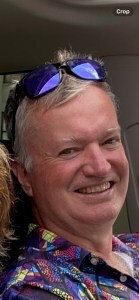
Screenshot
About the Author
Matt Cost was a history major at Trinity College. He owned a mystery bookstore, a video store, and a gym, before serving a ten-year sentence as a junior high school teacher. In 2014 he was released and began writing. And that’s what he does. He writes histories and mysteries.
Cost has published six books in the Mainely Mystery series, starting with Mainely Power. He has also published five books in the Clay Wolfe Trap series, starting with Wolfe Trap. And finally, there are two books in the Brooklyn 8 Ballo series, starting with Velma Gone Awry. For historical novels, Cost has published At Every Hazard and its sequel, Love in a Time of Hate, as well as I am Cuba. The Not So Merry Adventures of Max Creed is his 17th published book.
Cost now lives in Brunswick, Maine, with his wife, Harper. There are four grown children: Brittany, Pearson, Miranda, and Ryan. They have been replaced in the home with four dogs. Cost now spends his days at the computer, writing.
July 21, 2025
Poking a Hole in the Sky
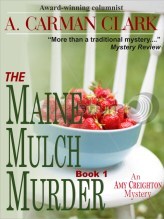 Kate Flora: In the summer, especially, I get nostalgic for the Maine I grew up in and my family when I was younger. It may be harder, or more present, this summer, because I’m in the process of selling the family woodland—which might well be called the ‘hundred acre wood’—to a land trust so it can be preserved as open land forever. First the family home, then the lots along the lake, and now the woods where we playing as children and even had ‘houses’ among the ledges and hid in the hollow oak. Time moves on, I know, but it still makes me sad.
Kate Flora: In the summer, especially, I get nostalgic for the Maine I grew up in and my family when I was younger. It may be harder, or more present, this summer, because I’m in the process of selling the family woodland—which might well be called the ‘hundred acre wood’—to a land trust so it can be preserved as open land forever. First the family home, then the lots along the lake, and now the woods where we playing as children and even had ‘houses’ among the ledges and hid in the hollow oak. Time moves on, I know, but it still makes me sad.
So what’s this about a hole in the sky? Well, recently while my husband and I were driving and talking about family and growing up and how we miss our parents and still have questions for them, he suggested that what we need is one day a year when we can poke a hole in the sky and ask those questions.
Wouldn’t that be great? There’s hardly a day that passes that I don’t have a question for my mother. She knew stuff, and when she didn’t know it, she was endlessly curious and would go and learn about it. She was a columnist for the Camden Herald, editing the home and garden page. If I had a question about plants, I knew she’d either have the answer or know where to find it. The farmhouse was full of reference books of all sorts, some of which now reside on my shelves.
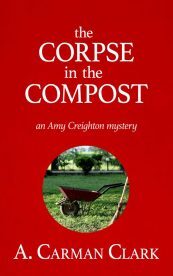 This summer, when the deer have eaten most of my hosta, the buds off the daylilies and roses, and munched the tops off the phlox, I know she’d have some interesting suggestions a) about deterrents, and b) about plants I could grow instead that the deer won’t eat. Yes, the nursery would have those answers, but it’s not the same as calling up my mom.
This summer, when the deer have eaten most of my hosta, the buds off the daylilies and roses, and munched the tops off the phlox, I know she’d have some interesting suggestions a) about deterrents, and b) about plants I could grow instead that the deer won’t eat. Yes, the nursery would have those answers, but it’s not the same as calling up my mom.
If I had that day, I would pull up the manuscript for her second, posthumously published mystery, The Corpse in the Compost, and ask her where she intended to go with the business about the vintage fabric. Was there a real house that fascinated her that she used for the model of the lovely, abandoned one in the book where the children found “treasure?” Were there reclusive citizens in town she used as models for the recalcitrant sisters in the book?
One of the things she taught me, by comments and curiosity as we drove around town, was how many people in small towns had secrets, and who knew about those secrets. The easily identified married man’s car parked by the house of an unmarried woman. The young woman who had to go away for several months to ‘stay with an aunt.’ The man who kept his beer in a shed because his daughter disapproved, who had to hitch rides to the next town when his supply ran out. Some of those stories ended up in her mysteries; some stayed secrets.
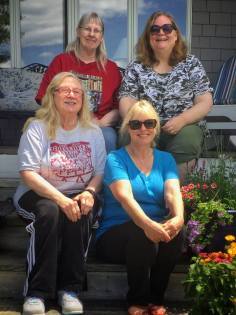 Poking that hole in the sky, I would roll out the giant ancestry map that she’d made by gluing some posters together, and learn what I could about the relatives who had been uncovered. She did her genealogical research back in my childhood by writing letters. Letters to older relatives to learn what they knew. Letters to towns and churches to see what their records had to say about long ago settlers. These days, people log into ancestry for the same information, but for her, going to the mailbox was like uncovering treasure.
Poking that hole in the sky, I would roll out the giant ancestry map that she’d made by gluing some posters together, and learn what I could about the relatives who had been uncovered. She did her genealogical research back in my childhood by writing letters. Letters to older relatives to learn what they knew. Letters to towns and churches to see what their records had to say about long ago settlers. These days, people log into ancestry for the same information, but for her, going to the mailbox was like uncovering treasure.
There’s no doubt that it was her love of information, and the uncovering and sharing of lore, that has led to my own fascination with novels that teach about people and places and professions while disclosing the mysteries.
It’s finally beautiful here on the coast of Maine. Cool, pleasant, and sunny. I think, although a manuscript is calling me, I will go outside and do some cloud watching. And remember my wise and clever mother, who would answer my questions if she could.
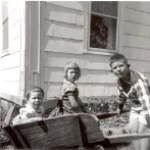
Clark children: John, Kate and Sara
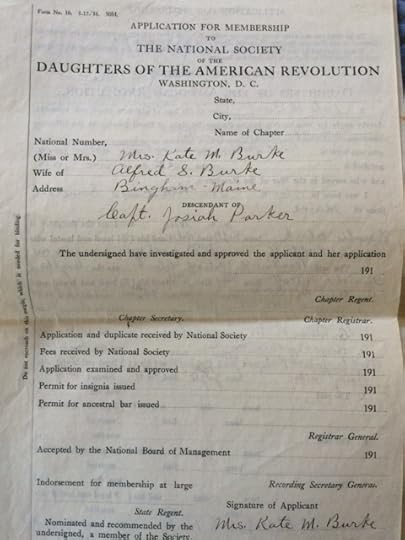
Draft application of Kate M. Burke, storekeeper in Bingham, Maine, to the DAR
P.S. Reading an essay in the NYT this week about AI, Meghan O’Rourke quotes a poem by Mary Oliver called “Sometimes.” It is the essence of what we writers do:
Instructions for living a life:
Pay attention.
Be astonished.
Tell about it.
July 18, 2025
Weekend Update: July 19-20, 2025
 Next week at Maine Crime Writers there will be posts by Kate Flora (Monday), Matt Cost (Tuesday), Maureen Milliken (Thursday), and Sandra Neily (Friday).
Next week at Maine Crime Writers there will be posts by Kate Flora (Monday), Matt Cost (Tuesday), Maureen Milliken (Thursday), and Sandra Neily (Friday).
In the news department, here’s what’s happening with some of us who blog regularly at Maine Crime Writers:
This coming Saturday, from 1-4, Maureen Milliken and Kate Flora will be at Sidereal Farm Brewery, 37 Sidereal Road, Vassalboro.
Kaitlyn Dunnett/Kathy Lynn Emerson here, pleased to report that, FINALLY!, Treacherous Visions is not only finished, it is available to buy in e-book ($5.99) and trade paperback ($15.99). The paperbacks may take a little while to arrive if you order one, since they are just now being printed, but I expect to have my copies within the next week or so.
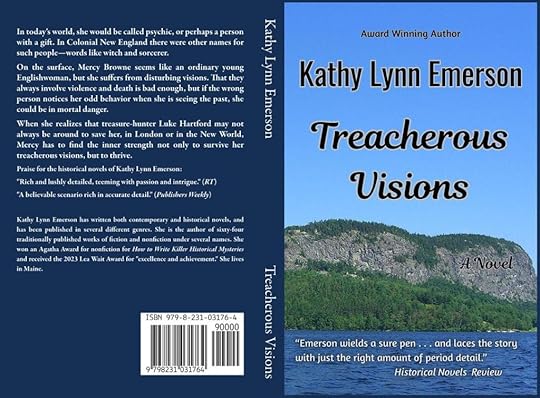
Today, Saturday July 19th, Matt Cost will be signing books at the Freeport Shermans Maine Coast Bookshop from 1-3 PM. Come say hi. Get a book. Get a scribble.
Sunday, July 20th, he will be doing a COST TALK at East Madison Days in East Madison at 1 PM. In a fire station. That will be a first. If in the area, come give a listen, have a Dynamite Hot Dog, and maybe bid on some fabulous silent auction items.
On Wednesday, July 23, he will be doing a COST TALK at the Shaw Public Library in Greenville at 4 PM. There might be a couple other reasons to head to Moosehead Lake that day, but this should be at the top of your list.
On Saturday, July 26th, Cost will be signing books for the Grand Opening of Books-A-Million in Auburn from 1-2:30 PM. Come check out the store. Check out the books. Get a scribble.
An invitation to readers of this blog: Do you have news relating to Maine, Crime, or Writing? We’d love to hear from you. Just comment below to share.
And a reminder: If your library, school, or organization is looking for a speaker, we are often available to talk about the writing process, research, where we get our ideas, and other mysteries of the business, along with the very popular “Making a Mystery” with audience participation, and “Casting Call: How We Staff Our Mysteries.” We also do programs on Zoom. Contact Kate Flora
July 17, 2025
At Long Last!
Kaitlyn Dunnett/Kathy Lynn Emerson here, pleased to report that, FINALLY!, Treacherous Visions is not only finished, it is available to buy in e-book ($5.99) and trade paperback ($15.99). The paperbacks may take a little while to arrive if you order one, since they are just now being printed, but I expect to have my copies within the next week or so.
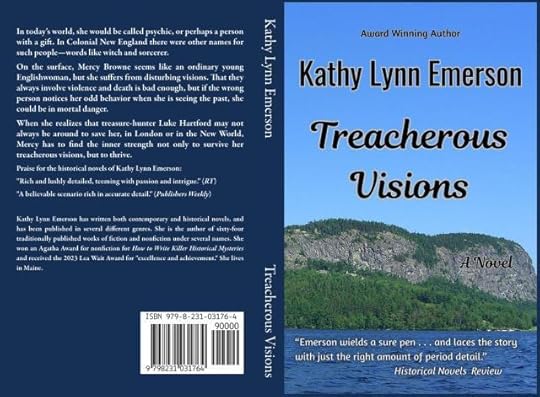
Am I happy with the finished product? Yes. Am I relieved to be finished with all the nit-picky details of final proofing and double-checking publication details. You betcha! And, by the time you read this, I will have done the basics of getting the word out. Since I no longer do library programs of book signings, that means updating my webpage, making noises about the new book here and on Facebook and Bluesky, and sending out a few emails to friends who aren’t on social media.
I know. I know. That’s not much these days. But I’m not trying to break any sales records or hit any bestseller lists and I don’t have to justify my existence to an editor or a publisher. The book is out there. That’s the important part. Anyone can buy a copy any time, and I have things set up so that it (and my other titles) will still be available after I’m gone. (Don’t worry. I’m fine. But I do try to plan for the future.)
I want to express my thanks to everyone who has sent me encouraging messages while I was working on this project, and to those who left comments here or elsewhere on my last blog on the subject of cover copy. You can see the result above. And you can see how I’ve presented the book on the Treacherous Visions page of my website here

Kathy Lynn Emerson/Kaitlyn Dunnett has had sixty-four books traditionally published and has self published others. She won the Agatha Award and was an Anthony and Macavity finalist for best mystery nonfiction of 2008 for How to Write Killer Historical Mysteries and was an Agatha Award finalist in 2015 in the best mystery short story category. In 2023 she won the Lea Wait Award for “excellence and achievement” from the Maine Writers and Publishers Alliance. She was the Malice Domestic Guest of Honor in 2014. She is currently working on creating new editions of her backlist titles. Her website is www.KathyLynnEmerson.com.
July 16, 2025
The Idea of Being a Writer
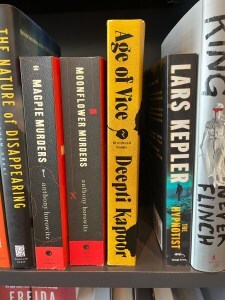 Rob Kelley here, and I was talking to one of my editors, Scott Wolven, after he and his partner-in-crime at High Frequency Press, Shanna McNair, did a joint reading of their two new books at Portland’s Print Bookstore in late June. Over drinks we talked about a technique he shares with writers striving to be published.
Rob Kelley here, and I was talking to one of my editors, Scott Wolven, after he and his partner-in-crime at High Frequency Press, Shanna McNair, did a joint reading of their two new books at Portland’s Print Bookstore in late June. Over drinks we talked about a technique he shares with writers striving to be published.
Go to your local bookstore (this photo is from one of mine, Arctic Tern in Rockland, ME), find where your book would be on the shelves and make room for it (I put it all back, I promise!). It’s a form of manifesting, I guess (anyone who knows me I’m the least woo-woo person on the planet), but it does create a powerful image.
The idea of being a writer has been in my head since I was a little kid reading and dreaming of creating worlds like the ones I was discovering. I tried my hand at stories, but I was missing a critical ingredient that would let me go the distance: space. Space in my brain to let out my wild, creative self (not super easy for me . . . see woo-woo, above) and space in my life to take the time to do it right. To write, revise, incubate, revise and repeat. To go to classes and conferences and become a student again.
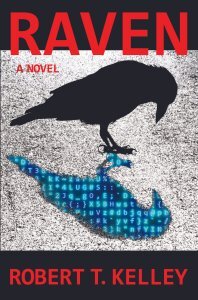 More than a student, a practitioner of shoshin, the Zen Buddhist concept of “beginner’s mind.” As a type-A kind of guy, I really hate being bad at something, being a beginner. And while, yes, I had an exceptionally busy professional career, I wrote a very early precursor to Raven (forthcoming 2025, High Frequency Press) in the 1990s! But it wasn’t very good, and I knew it. I chipped away at it over the next few years but didn’t really make any progress on it until around ten years ago when I picked it back up and started doing real work.
More than a student, a practitioner of shoshin, the Zen Buddhist concept of “beginner’s mind.” As a type-A kind of guy, I really hate being bad at something, being a beginner. And while, yes, I had an exceptionally busy professional career, I wrote a very early precursor to Raven (forthcoming 2025, High Frequency Press) in the 1990s! But it wasn’t very good, and I knew it. I chipped away at it over the next few years but didn’t really make any progress on it until around ten years ago when I picked it back up and started doing real work.
I started attending writing conferences and getting serious about working explicitly on my craft. I took a Stanford Continuing Studies class online, then started going to the Muse and the Marketplace conferences that Grub Street puts on in Boston. Then came Maine Writers and Publishers Crime Wave here in Portland, ME and Crime Bake in Boston. I took masters classes at Thriller Fest in NYC as well as here in Maine with our fabulous thriller writer colleagues Gayle Lynds and Chris Holm.
 The point of all that is that I needed to create the mental space to be a beginner, a state I worked hard to rediscover, and one I keep fresh by always trying to be humble in my writing (funny how the work seems to do that for me!), while also trying new things to challenge myself, most recently taking up the cello!
The point of all that is that I needed to create the mental space to be a beginner, a state I worked hard to rediscover, and one I keep fresh by always trying to be humble in my writing (funny how the work seems to do that for me!), while also trying new things to challenge myself, most recently taking up the cello!
What keeps you fresh, keeps you a beginner?
Also, beginning this month I’m adding a new feature to my monthly blog post: currently reading and next in the TBR list!
 Currently reading: Agents of Innocence, David Ignatius, 1987.
Currently reading: Agents of Innocence, David Ignatius, 1987.
 Next from the TBR list: King of Ashes, SA Cosby, 2025.
Next from the TBR list: King of Ashes, SA Cosby, 2025.
Lea Wait's Blog
- Lea Wait's profile
- 507 followers



